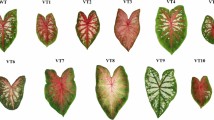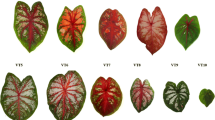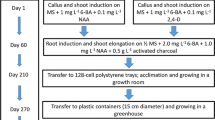Abstract
Cultivated caladiums (Caladium × hortulanum Birdsey) are popular ornamental plants. Although somaclonal variation occurs frequently in caladium during tissue culture, little research has been conducted on obtaining and detecting variants from long-term callus cultures. Herein, plants were regenerated from ‘Red Flash’ caladium calluses subcultured for approximately 40 mo, and 116 out of 520 established plants were grouped into 14 somaclonal variation types based on their morphological differences. Nuclear DNA content of six types (SVT1, SVT2, SVT4, SVT5, SVT8, and SVT10) varied from − 1.08% to 0.33% compared with the wild type, and these variants shared a similar chromosome number to the wild caladium (2n = 2x = 30). Three types (SVT3, SVT7, and SVT9) containing 2.82 to 5.42% less nuclear DNA content was the result of losing one or two chromosomes, and one type (SVT6) with significantly lower cellular DNA content was due to losing four chromosomes. Four types (SVT11–SVT14) contained 85.16 to 101.52% more DNA content and the SVT12 and the SVT13 had a double number of chromosomes (2n = 4x = 60), while the SVT11 and SVT14 had four more chromosomes and six less chromosomes as compared with a typical tetraploid, respectively. Correlation analysis suggested that leaf thickness, leaf index, and stomatal characteristics could be used as indicators of plant ploidy in caladium. A wide variation of pigment content was found among the variation types, and the content of chlorophyll, flavonoid, and anthocyanin had a significant positive correlation with the color parameters a* and b*. Leaf color variants created by prolonged in vitro callus cultures might hold great promise for caladium breeding.





Similar content being viewed by others
References
Ahmed EU, Hayashi T, Yazawa S (2004) Auxins increase the occurrence of leaf-colour variants in caladium regenerated from leaf explants. Sci Hortic 100:153–159
Bairu MW, Aremu AO, Van Staden J (2011) Somaclonal variation in plants: causes and detection methods. Plant Growth Regul 63:147–173
Beck SL, Dunlop RW, Fossey A (2003) Stomatal length and frequency as a measure of ploidy level in black wattle, Acacia mearnsii (de wild). Bot J Linn Soc 141:177–181
Cai XD, Cao Z, Xu SX, Deng Z (2015) Induction, regeneration and characterization of tetraploids and variants in ‘tapestry’ caladium. Plant Cell Tiss Org Cult 120:689–700
Cai XD, Deng Z (2016) Thidiazuron promotes callus induction and proliferation in Caladium x Hortulanum Birdsey UF-4609. Propag Ornam Plant 16:90–97
Cao Z, Sui SZ, Cai XD, Yang Q, Deng Z (2016a) Somaclonal variation in ‘Red Flash’ caladium: morphological, cytological and molecular characterization. Plant Cell Tiss Org Cult 126:269–279
Cao Z, Sui SZ, Yang Q, Deng Z (2016b) Inheritance of rugose leaf in caladium and genetic relationships with leaf shape, main vein color, and leaf spotting. J Am Soc Hortic Sci 141:527–534
Cerovic ZG, Masdoumier G, Ghozlen NB, Latouche G (2012) A new optical leaf-clip meter for simultaneous non-destructive assessment of leaf chlorophyll and epidermal flavonoids. Physiol Plant 146:251–260
Deng Z (2012) Caladium genetics and breeding: recent advances. Floric Ornam Biotechnol 6:53–61
Deng Z (2018) Caladium. In: Van Huylenbroeck J (ed) Ornamental crops, Handbook of plant breeding, vol 11. Springer, Cham, pp 273–299
Deng Z, Goktepe F, Harbaugh BK (2008) Inheritance of leaf spots and their genetic relationships with leaf shape and vein color in caladium. J Am Soc Hortic Sci 133:78–83
Deng Z, Harbaugh BK (2006) Independent inheritance of leaf shape and main vein color in caladium. J Am Soc Hortic Sci 131:53–58
Feild TS, Lee DW, Holbrook NM (2001) Why leaves turn red in autumn. The role of anthocyanins in senescing leaves of red-osier dogwood. Plant Physiol 127:566–574
Huettel B, Kreil DP, Matzke M, Matzke AJ (2008) Effects of aneuploidy on genome structure, expression, and interphase organization in Arabidopsis thaliana. PLoS Genet 4(10):e1000226
Hussain S, Curk F, Dhuique-Mayer C, Urban L, Ollitrault P, Luro F, Morillon R (2012) Autotetraploid trifoliate orange (Poncirus trifoliata) rootstocks do not impact clementine quality but reduce fruit yields and highly modify rootstock/scion physiology. Sci Hortic 134:100–107
Krishna H, Alizadeh M, Singh D, Singh U, Chauhan N, Eftekhari M, Sadh RK (2016) Somaclonal variations and their applications in horticultural crops improvement. 3. Biotech 6:54
Kumar PS, Mathur VL (2004) Chromosomal instability in callus culture of Pisum sativum. Plant Cell Tiss Org Cult 78:267–271
Lancaster JE, Lister CE, Reay PF, Triggs CM (1997) Influence of pigment composition on skin color in a wide range of fruit and vegetables. J Am Soc Hortic Sci 122:594–598
Li WX, Yang SB, Lu ZG, He ZC, Ye YL, Zhao BB, Wang L, Jin B (2018) Cytological, physiological, and transcriptomic analyses of golden leaf coloration in Ginkgo biloba L. Hortic Res 5:12
Loureiro J, Rodriguez E, Doležel J, Santos C (2007) Two new nuclear isolation buffers for plant DNA flow cytometry: a test with 37 species. Ann Bot 100:875–888
Marie D, Brown SC (1993) A cytometric exercise in plant DNA histograms with 2C values for 70 species. Biol Cell 78:41–51
Murashige T, Skoog F (1962) A revised medium for rapid growth and bio assays with tobacco tissue cultures. Physiol Plant 15:473–497
Rodríguez-Calzada T, Qian M, Strid Å, Neugart S, Schreiner M, Torres-Pacheco I, Guevara-González RG (2019) Effect of UV-B radiation on morphology, phenolic compound production, gene expression, and subsequent drought stress responses in chili pepper (Capsicum annuum L.). Plant Physiol Biochem 134:94–102
Sarmah D, Sutradhar M, Singh BK (2017) Somaclonal variation and its application in ornamentals plants. Int J Pure App Biosci 5:396–406
Sato M, Kawabe T, Hosokawa M, Tatsuzawa F, Doi M (2011) Tissue culture-induced flower-color changes in Saintpaulia caused by excision of the transposon inserted in the flavonoid 3′, 5′ hydroxylase (F3′5′H) promoter. Plant Cell Rep 30:929–939
Thepsithar C, Thongpukdee A, Chiensil P (2010) Micropropagation of Caladium bicolor (Ait.) vent. ‘Thep Songil’ and incidence of somaclonal variants. Acta Hortic 855:273–280
Thongpukdee A, Thepsithar C, Chiensil P (2010) Somaclonal variation of Caladium bicolor (Ait.) vent. ‘Jao Ying’ after in vitro culture propagation. Acta Hortic 855:281–288
Wilfret GJ (1993) Caladium. In: de Hertogh A, le Nard M (eds) The physiology of flower bulbs. Elsevier Amsterdam, pp 239–247
Żabicki P, Sliwinska E, Mitka J, Sutkowska A, Tuleja M, Migdałek G, Żabicka J, Słomka A, Kwiatkowska M, Kuta E (2019) Does somaclonal variation play advantageous role in conservation practice of endangered species?: comprehensive genetic studies of in vitro propagated plantlets of Viola stagnina Kit. (Violaceae). Plant Cell Tiss Org Cult 136:339–352
Zhang YS, Gu SJ, Chen JJ, Cai XD (2019) Effects of different nutrient solutions on the acclimatization of in vitro Caladium plantlets using a simplified hydroponic system. Sains Malays 48:1627–1633
Acknowledgments
We are grateful to Dr. Zhanao Deng (Gulf Coast Research and Education Center, University of Florida, Wimauma, Florida, United States of America) for providing the ‘Red Flash’ caladium.
Funding
This study was funded in part by the Scientific Research Project of Hubei Education Department of China (No. B2018024).
Author information
Authors and Affiliations
Corresponding author
Ethics declarations
Conflict of interest
The authors declare that they have no conflicts of interest.
Additional information
Editor: Neftali Ochoa-Alejo
Rights and permissions
About this article
Cite this article
Chen, JJ., Zhang, YS., Duan, JX. et al. Morphological, cytological, and pigment analysis of leaf color variants regenerated from long-term subcultured caladium callus. In Vitro Cell.Dev.Biol.-Plant 57, 60–71 (2021). https://doi.org/10.1007/s11627-020-10106-8
Received:
Accepted:
Published:
Issue Date:
DOI: https://doi.org/10.1007/s11627-020-10106-8




